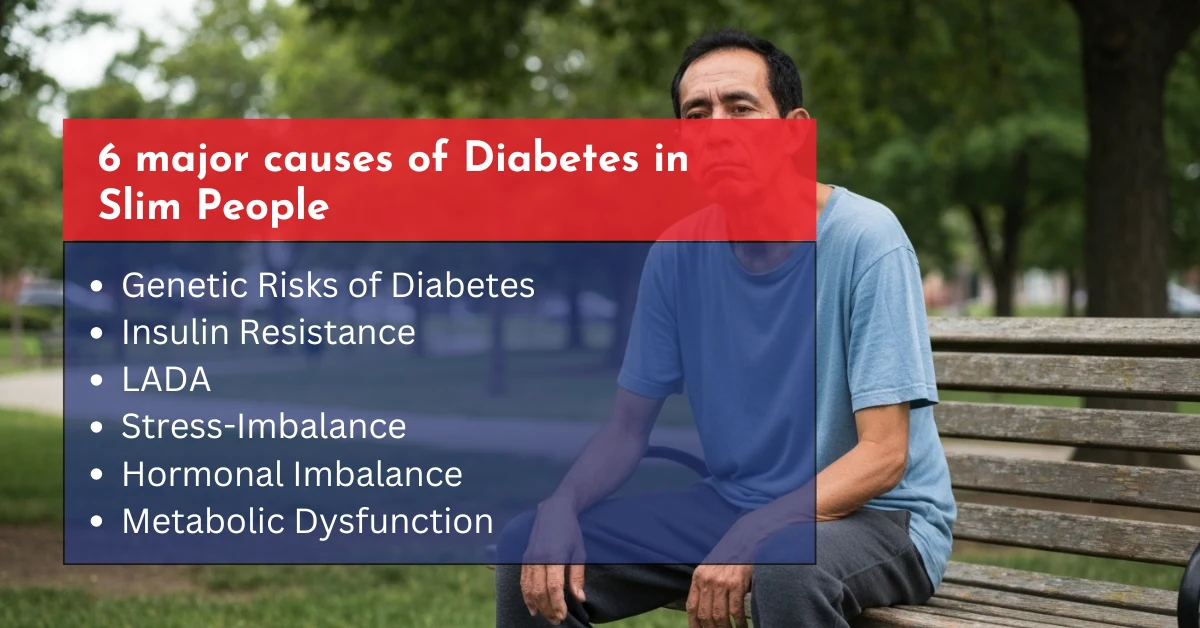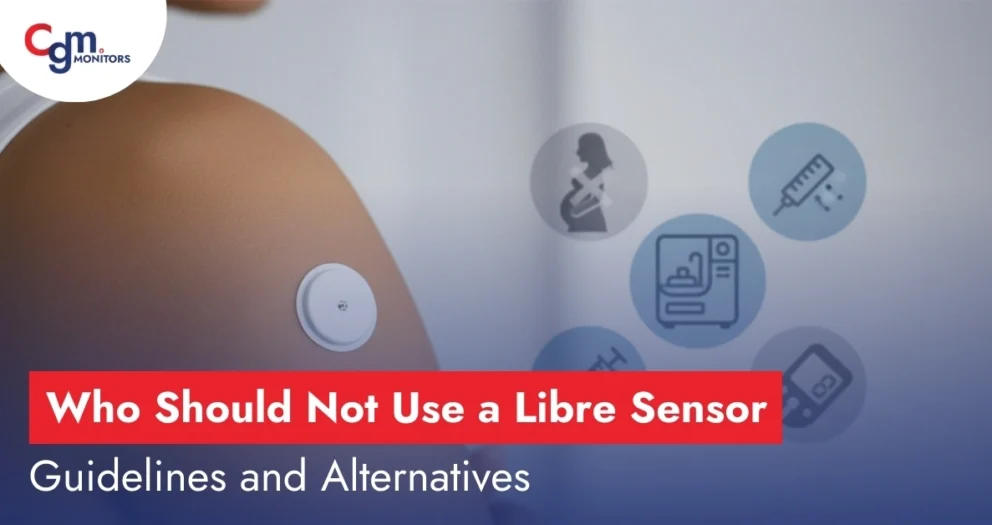Can Skinny People Get Diabetes? 6 Causes, Symptoms, and Cures

Table of content
- Can Thin People Develop Type 2 Diabetes?
- Top 6 Major Causes of Diabetes in Slim People
- 7 Signs of Diabetes in Skinny People: Quick Overview
- Diagnosing Diabetes in Lean Patients
- Visceral Fat in Skinny People: The Hidden Risk
- Preventing Diabetes in Slim Individuals
- Why CGM Use in Lean Individuals Is Essential
- Key Benefits:
- Final Thoughts: Can Skinny People Get Diabetes?
- People Asked For
Type 2 diabetes is associated and portrayed everywhere with excess body weight. However, people ask: “Can skinny people get diabetes?” The answer is yes. An increasing number of lean people are being diagnosed with type 2 diabetes, which contradicts long-held beliefs about body weight and metabolic health. This emerging condition, non-obese diabetes, lean diabetes or diabetes in slim individuals, is often ignored because such patients do not fit the typical profile of an obese person.
This article explains lean diabetes, which affects people who are not overweight. It looks at causes like family history, visceral fat, and chronic stress. It also shows how CGM systems help with early detection and personalized care for lean individuals.
Can Thin People Develop Type 2 Diabetes?
Yer! Thin individuals can be susceptible to type 2 diabetes. Although most health messages emphasise the relationship of elevated Body Mass Index (BMI) with diabetes, research indicates that even those with a lower BMI are not spared.
The American Diabetes Association suggests that about 15% of newly diagnosed type 2 diabetes cases are recorded in people with normal or low BMI. Sadly, routine screenings tend to overlook these cases, and patients often receive diagnoses only after complications have arisen.
Top 6 Major Causes of Diabetes in Slim People
There are several reasons non-obese individuals develop type 2 diabetes.
- Genetic Risk of Diabetes: Having a strong family history of diabetes greatly increases your risk greatly irrespective of weight. A parent or sibling’s diabetes increases the chances of having prominent glucose metabolism changes. This can lead to diminished insulin sensitivity and beta-cell dysfunction in even slim individuals.
Discover insights about your genes and learn how your body may respond to over 250 medications on Rph Labs.
- Insulin Resistance in Lean Individuals. Some slender people may fall into the TOFI category, Thin Outside, Fat Inside. These individuals may look slim on the outside, but have hidden visceral fat around internal organs. This fat distribution is harmful and leads to insulin resistance, inflammation, and glucose intolerance, which drives diabetes.
- LADA: It is often misclassified as type 2 diabetes; basically, it’s a form of autoimmune disorder that is more akin to type 1 diabetes. It tends to be more gradual and is most often seen in leaner adults. Standard treatments such as oral hypoglycemic agents do not work effectively on LADA. Without early recognition and insulin therapy, patients experience rapid beta-cell loss and poor glycemic control.
- Stress-Induced Diabetes: Chronic psychological or physical stress triggers a hormonal cascade involving cortisol, which interferes with glucose metabolism. This effect, combined with poor sleep, irregular routines, and mental fatigue, contributes to diabetes onset in non-obese individuals.
- Hormonal Imbalances: Hormonal disorders such as Polycystic Ovary Syndrome (PCOS) and thyroid dysfunction can impair insulin regulation even in women of normal weight. For instance, lean women with PCOS may have significant insulin resistance despite lacking obvious symptoms like weight gain.
- Eating Disorders and Metabolic Dysfunction: Conditions like bulimia, binge-eating, and starvation cycles destabilise the pancreas, leading to impaired insulin production. These irregular eating habits can overload metabolic pathways, increasing the risk of diabetes, even in those who appear physically healthy.

7 Signs of Diabetes in Skinny People: Quick Overview
Early signs of diabetes in lean individuals can be subtle. Without the visual trigger of obesity, these symptoms are often misattributed to lifestyle or diet.
| Symptom | Clinical Implication |
| Persistent fatigue | Indicates poor cellular glucose uptake |
| Increased thirst | Suggests hyperglycemia and dehydration |
| Frequent urination | A response to excess glucose excretion |
| Unexplained weight loss | A key sign of insulin deficiency or glucose wastage |
| Blurry vision | Osmotic changes from elevated blood sugar |
| Slow-healing wounds | Reflects vascular damage and impaired immunity |
| Mood swings and brain fog | Indicate glucose variability and insulin imbalances |
Brain fog (basically used for certain symptoms that can affect your ability to think), post-meal drowsiness, or lightheadedness in lean individuals often point to reactive hypoglycemia or insulin resistance, early indicators of diabetes risk.
Diagnosing Diabetes in Lean Patients
Many healthcare providers overlook diabetes in slim patients due to “normal BMI bias”. However, several tests are essential for accurate diagnosis:
- Fasting Plasma Glucose (FPG) provides a snapshot of baseline glucose levels.
- Haemoglobin A1c offers an average of blood sugar over the past 2–3 months.
- Oral Glucose Tolerance Test (OGTT) assesses the body’s response to a glucose challenge.
- C-Peptide testing helps differentiate LADA from type 2 diabetes by evaluating insulin production.
- Autoantibody screening (e.g., GAD65, IA-2, ZnT8) detects autoimmune forms of diabetes like LADA.
Modern tools like CGMs from Cgm monitors enhance diagnosis by offering real-time glucose tracking, identifying postprandial spikes, and highlighting glycemic variability that lab tests may miss.
Visceral Fat in Skinny People: The Hidden Risk
Even thin people can accumulate visceral fat, the deep fat surrounding vital organs. This type of fat is metabolically active and strongly associated with insulin resistance, inflammation, and cardiovascular risk.
While BMI might appear normal, the waist-to-hip ratio and imaging tests like DEXA scans or MRI are more accurate indicators of metabolic health. Elevated C-reactive protein (CRP) levels can also signal systemic inflammation due to visceral fat.
This hidden fat can lead to:
- Chronic inflammation
- Endothelial dysfunction
- Fatty liver disease (NAFLD)
- Atherosclerosis
Because it’s not visible externally, clinicians must assess metabolic risk based on waist measurements, lab tests, and glucose markers, rather than relying on body weight alone. For more insights on Visceral fat, read this article.
Preventing Diabetes in Slim Individuals
Prevention in lean individuals isn’t about losing weight but improving metabolic flexibility and insulin function.
1. Dietary Strategies
A tailored diet helps maintain stable glucose levels:
- Prioritise low-glycemic index (GI) carbohydrates to reduce blood sugar spikes.
- Pair carbs with protein and healthy fats to slow digestion and support insulin response.
- Increase soluble fibre intake, such as oats, legumes, and chia seeds, which promote better glucose absorption.
- Avoid refined sugars and processed foods that provoke rapid glucose surges.
With CGM devices like Freestyle Libre 3 Plus, users can observe real-time glucose changes in response to meals, allowing personalised diet adjustments.
2. Exercise Prescription
Even lean individuals benefit from consistent movement:
- Aim for 150 minutes of moderate aerobic activity per week, such as brisk walking or cycling.
- Incorporate resistance training to boost muscle mass, which improves insulin sensitivity.
- Short walks after meals help reduce postprandial glucose levels and enhance mitochondrial function.
3. Sleep and Lifestyle Optimisation
Lifestyle changes significantly impact glucose metabolism:
- Get 7–8 hours of quality core sleep per night to avoid cortisol-induced glucose elevation.
- Practice stress-reduction techniques like CBT, deep breathing, or mindfulness.
- Stay hydrated, as water helps the kidneys flush excess glucose.
Poor sleep and unmanaged stress can elevate blood sugar even in slim individuals, accelerating the risk of prediabetes.
Why CGM Use in Lean Individuals Is Essential
CGM (Continuous Glucose Monitoring) devices, like those offered by CGM Monitors, provide vital data that goes far beyond lab tests.
Key Benefits:
| CGM Feature | Value for Lean Patients |
| 24/7 glucose data | Detects abnormal fluctuations missed by periodic labs |
| Pattern tracking via smart apps | Enables diet and activity customisation |
| Hypoglycemia alerts | Helps identify reactive hypoglycemia in thin individuals |
| Early prediabetes detection | Detects issues even before HbA1c elevates |
| Data-driven care | Guides interventions without guessing |
A 2024 Dexcom Clinical Review showed CGMs detect glycemic instability in lean individuals months or years before traditional tests catch abnormalities.
Final Thoughts: Can Skinny People Get Diabetes?
Absolutely. Skinny people can get diabetes, and because they don’t fit the traditional profile, their condition is often more dangerous due to underdiagnosis. From TOFI syndrome and LADA to genetic predisposition, visceral fat, and stress-related dysregulation, non-obese diabetes reflects a multifaceted metabolic issue not defined by body size.
Medical devices like CGM monitors from Cgm Monitors offer a revolutionary approach for real-time monitoring, allowing early interventions that prevent complications before they begin. Regardless of weight, every individual at risk should consider glucose screening, because diabetes doesn’t care how much you weigh.
People Asked For
How common is diabetes in non-obese individuals?
Diabetes in non-obese individuals affects 10-15% of type 2 cases. Even with normal weight, certain ethnicities like Asians show up to 17% prevalence.
How does genetics play a role in thin people getting diabetes?
Genetics influence beta cell function and insulin secretion. Variants in genes like TCF7L2 and KCNJ11, family history, and low birth weight increase risk, even without excess weight.
How can a thin person prevent diabetes?
Thin individuals can prevent diabetes by eating nutrient-rich foods, exercising 150+ minutes weekly, managing stress, getting 7-9 hours sleep, and avoiding smoking.
What is lean diabetes?
Lean diabetes is type 2 diabetes in people with low or normal BMI (<25), driven by insulin secretion defects rather than insulin resistance, often presenting earlier in life.
Are there specific dietary habits that increase diabetes risk in skinny people?
Yes. High-sugar drinks, refined carbs, saturated fats, processed snacks, and irregular meals can raise blood sugar and insulin resistance, even in lean individuals.
Can skinny people get type 2 diabetes?
Yes. Genetics, sedentary lifestyle, and visceral fat (“skinny fat”) contribute to type 2 diabetes in slim people, affecting roughly 10-15% of cases.
When should a doctor test a thin person for diabetes?
Testing is advised for symptoms like thirst, frequent urination, fatigue, weight loss, delayed healing, or for those with family history, prediabetes, or age over 45.
Where does fat accumulate in thin people with diabetes?
In thin diabetics, fat primarily accumulates as visceral fat around organs, releasing compounds that impair insulin, often without visible weight gain.
Which medical conditions increase diabetes risk in normal weight individuals?
Conditions like PCOS, fatty liver, abnormal cholesterol, gestational diabetes history, pancreatitis, or autoimmune issues increase diabetes risk despite normal weight.
What lifestyle changes can reduce diabetes risk in non-overweight individuals?
Focus on whole foods, fiber, limited sugars, regular exercise, stress reduction, proper sleep, quitting smoking, and monitoring metabolic health.
What are the risk factors for diabetes in lean individuals?
Risk factors include genetics, family history, ethnicity, inactivity, poor nutrition, smoking, alcohol, early-life malnutrition, age, high triglycerides, and pancreatitis.







Write a comment
Your email address will not be published. All fields are required